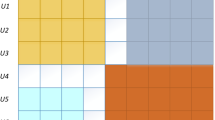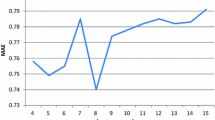Abstract
With the rapid development of internet economy, personal recommender system plays an increasingly important role in e-commerce. In order to improve the quality of recommendation, a variety of scholars and engineers devoted themselves in developing the recommendation algorithms. Traditional collaborative filtering algorithms are only dependent on rating information or attribute information. Most of them were considered in perspective of a single-layer network, which destroyed the original hierarchy of data and resulted in sparse matrix and poor timeliness. In order to address these problems and improve the accuracy of recommendation, dynamic clustering collaborative filtering recommendation algorithm based on double-layer network is put forward in this paper. Firstly, attribute information of users and items are respectively used to construct the user layer network and the item layer network. Secondly, new hierarchical clustering method is further presented, which separates users into different communities according to dynamic evolutionary clustering. Finally, score prediction and top-N recommendation lists are obtained by similarity between users in each community. Extensive experiments are conducted with three real datasets, and the effectiveness of our algorithm is verified by different metrics.









Similar content being viewed by others
Explore related subjects
Discover the latest articles, news and stories from top researchers in related subjects.References
Kuo YT, Chen PY, Lin HC (2020) A spatiotemporal content-based CU size decision algorithm for HEVC. IEEE Trans Broadcast 66(1):100–112
Messina P, Dominguez V, Parra D (2019) Content-based artwork recommendation: integrating painting metadata with neural and manually-engineered visual features. User Model User Adapt Interact 29:251–290
Polatidis N, Georgiadis CK (2017) A dynamic multi-level collaborative filtering method for improved recommendations. Comput Stand Interfaces 51:14–21
Ya-Wen D, Ke L (2019) A fusion collaborative filtering recommendation algorithm based on user and item’s similarity. Comput Inf Technol 27(1):6–10
Bag S, Kumar SK, Tiwari MK (2019) An efficient recommendation generation using relevant Jaccard similarity. Inf Sci 483:53–64
Valcarce D, Parapar J (2016) Item-based relevance modelling of recommendations for getting rid of long tail products. Knowl Based Syst 103:41–51
Shi HY, Chen L, Xu ZX et al (2019) Personalized location recommendation using mobile phone usage information. Appl Intell 49:3694–3707
Liu HT, Wang Y, Peng QY et al (2020) Hybrid neural recommendation with joint deep representation learning of ratings and reviews. Neurocomputing 374:77–85
Cai XJ, Hu ZM, Zhao P et al (2020) A hybrid recommendation system with many-objective evolutionary algorithm. Expert Syst Appl 159:116648
Zhao XY, Xia L, Yin DW, et al (2019) Model-based reinforcement learning for whole-chain recommendations. In: The 13th ACM international conference on web search and data mining, pp 4–8
Cai X, Hu Z, Chen J (2020) A many-objective optimization recommendation algorithm based on knowledge mining. Inf Sci 537:148–161
Chen C, Zhang M, Zhang Y et al (2020) Efficient neural matrix factorization without sampling for recommendation. ACM Trans Inf Syst 38(2):1–28
Silveira T, Zhang M, Lin X et al (2019) How good your recommender system is? A survey on evaluations in recommendation. Int J Mach Learn Cybern 10(5):813–831
Zhang YF, Chen X (2020) Explainable recommendation: a survey and new perspectives. Found Trends Inf Retr 14(1):1–101
Ebbinghaus H, Ruger HA, Bussenius CE (2013) Memory: a contribution to experimental psychology. Ann Neurosci 20(4):155–156
Xue YL, Xu LY, Yu J et al (2016) Memory-forgetting curve based on virtual and real spaces for commercial recommendation. In: Proceedings of the 9th EAI international conference on mobile multimedia communications, pp 205–209
Chen JR, Wei LD, Uliji et al (2018) Dynamic evolutionary clustering approach based on time weight and latent attributes for collaborative filtering recommendation. Chaos Solitons Fractals 114:8–18
Liu TC, Liao JX, Wu ZG et al (2020) Exploiting geographical-temporal awareness attention for next point-of-interest recommendation. Neurocomputing 400:227–237
Koohi H, Kiani K (2016) User based collaborative filtering using fuzzy C-means. Measurement 91:134–139
Kaur M, Batra S (2017) A novel trust mechanism for collaborative recommendation systems. Comput Netw Sustain Lect Notes Netw Syst 12:343–351
Chen JR, Uliji A (2018) Evolutionary heterogeneous clustering for rating prediction based on user collaborative filtering. Swarm Evol Comput 38:34–41
Jiang WJ, Chen JH, Jiang YR et al (2019) A new time-aware collaborative filtering intelligent recommendation system. Compu Mater Continua 58(2):849–859
Yin YY, Chen L, Xu YS et al (2019) QoS prediction for service recommendation with deep feature learning in edge computing environment. Mobile Netw Appl 25:391–401
Bi JW, Liu Y, Fan ZP (2020) A deep neural networks based recommendation algorithm using user and item basic data. Int J Mach Learn Cybern 11:763–777
Wang XH, Peng ZH, Wang SZ et al (2020) CDLFM: cross-domain recommendation for cold-start users via latent feature mapping. Knowl Inf Syst 62(5):1723–1750
Moradi P, Ahmadian S, Akhlaghian F (2015) An effective trust-based recommendation method using a novel graph clustering algorithm. Phys A 436:462–481
Ren J, Long J, Xu Z (2019) Financial news recommendation based on graph embeddings. Decis Support Syst 125:113115
Ding Y, Li X (2005) Time weight collaborative filtering. In: The 14th ACM international conference on information & knowledge management, vol 1, pp 485–492
Leon D, Albert D, Jordi D et al (2005) Comparing community structure identification. J Stat Mech 09:09008
Wu JS, Jiao LC, Jin C et al (2012) Overlapping community detection via network dynamics. Phys Rev E 85(2):016115
Wu JS, Zhang L, Li Y et al (2016) Partition signed social networks via clustering dynamics. Phys A 443:568–582
Chen JR, Wang H, Wang L et al (2016) A dynamic evolutionary clustering perspective: community detection in signed networks by reconstructing neighbor sets. Phys A 447:482–492
Maia DMN, Oliveira JEMD et al (2017) Community detection in complex networks via adapted Kuramoto dynamics. Commun Nonlinear Sci Numer Simul 53:130–141
Chen JR, Wang B, Uliji A et al (2019) Personal recommender system based on user interest community in social network model. Phys A 526:120961
Gerald T (2004) Ordinary differential equations and dynamical systems. Atlantis Stud Differ Equ 140(3):189–194
Srikanth T, Shashi M (2015) A new similarity measure for user-based collaborative filtering in recommender systems. Int J Comput Technol 14(9):6118
Zheng CC, Li L (2014) Research on method of similarity measurement in collaborative filter algorithm. Comput Eng Appl 50(8):147–149
Upendra S, Pattie M (1995) Social information filtering: algorithm for automating ‘Word of Mouth’ 110(1):210–217
Paolo C, Yehuda K, Roberto T (2010) Performance of recommender algorithms on top-n recommendation tasks. In: ACM conference on recommender systems, pp 39–46
Shang FH, Liu YY, James C (2018) Fuzzy double trace norm minimization for recommendation systems. IEEE Trans Fuzzy Syst 26(4):2039–2049
Acknowledgements
This research was supported through National Natural Science Foundation of China (No. 71561020, 61503203, 61702317, 61771297); Fundamental Research Funds for the Central Universities (No. GK201802013).
Author information
Authors and Affiliations
Corresponding author
Additional information
Publisher's Note
Springer Nature remains neutral with regard to jurisdictional claims in published maps and institutional affiliations.
Rights and permissions
About this article
Cite this article
Chen, J., Wang, B., Ouyang, Z. et al. Dynamic clustering collaborative filtering recommendation algorithm based on double-layer network. Int. J. Mach. Learn. & Cyber. 12, 1097–1113 (2021). https://doi.org/10.1007/s13042-020-01223-2
Received:
Accepted:
Published:
Issue Date:
DOI: https://doi.org/10.1007/s13042-020-01223-2




